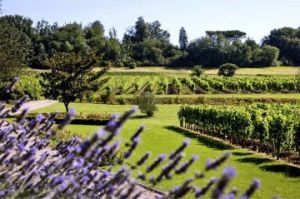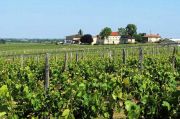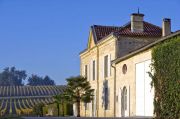 |

|
 Château Tessendey © P.Roy Château Tessendey © P.Roy

|
Because of its 1855 classification and the limited number of permitted grape varieties, Bordeaux is often seen perceived as one of the most conservative French wine regions. But things change. More and more winemakers from this region are now making quality wines retaining the Bordeaux typicity but easy to drink and able to please a wide range of customers.
[ Practical ]
- Château Lajarre
24 avenue des Châteaux, 33350 Mouliets et Villemartin
Tel : 0557410869
www.chateau-lajarre.com
- Château Tessendey
33141 Saillans
Tel : 0557843226
- Château Saint-Nicolas
Le Videau, 33410 Cerdan
Tel : 0556767237
- Château Mancèdre
23-25 Chemin de Bougès, 33850 Léognan
Tel : 0557743052
www.roy-trocard.com
- Château La Claymore
Maison Neuve, 33570 Lussac
Tel : 0557746748
www.laclaymore.fr
- Château Moulin de Clotte
Le Chais, 33570 Puisseguin
Tel : 0557552328
www.vignobles-lannoye.com
- In a Bottle
www.inabottle.fr
This is the case of the 16 winemakers running 26 estates who have joined together to form the In a Bottle club at the initiative of Labo Oeno Team made up of three dynamic oenologists : Stéphane Toutoundji, Thomas Duclos and Julien Belle.
Locally born or originating from other parts of France and settled in Bordeaux to realize their dream of creating wine, they share the same vision of their profession: to produce wines representative of their appellation and their terroir but also reflecting their personality and being adapted to customer expectations. An objective they aim to achieve by sharing their experiences, following the advice of Oeno Lab Team’s winemakers and organizing joint communication operations and joint tasting. Here are some of them.
 Château Lajarre Château Lajarre
Also a doctor, Gregory Lovato dragged up Château Lajarre among the best wineries of the Bordeaux Supérieur appellation. It is also one of the most beautiful because the building is the work of Charles Burguet, a 19th century architect from Bordeaux who also designed the Château Palmer. Located ten miles south of Saint-Emilion, the property boasts 32 hectares of vines managed with low-input farming practices and yields are limited to 45 hl / ha. Since he took charge of the estate, in 2005, Gregory Lovato has modernized the winery and replanted some plots in order to get the proportion of grape varieties better suited to his terroir: 80% Merlot and 20% Cabernet Franc. Thanks to these efforts, his Eleanor cuvee is a well balanced, fruity, delicate and complex wine with a long finish that needs to age a bit to develop its full potential. A very good value wine.

 Château Tessendey © P.Roy Château Tessendey © P.Roy
|
 Château Tessendey Château Tessendey
On the right bank of the Garonne, near Libourne, Château Tessendey is another winery that is worth seeing for its wine and its architecture because it is a superb 19th century mansion surrounded by a beautiful garden. Located in the Fronsac appellation where landscapes are composed of vineyards, woodlands and hills, this family property was renovated in 2000 and, since 2010, led by Arnaud Arfeuille previously sales executive at Fauchon and Ricard. Covering an area of 8 hectares planted with Merlot and Cabernet Franc, the vineyard extends on a perfectly sunny hillside and gives a powerful, fleshy and smooth wine with black fruits aromas. A good deal too.

 Château Saint Nicolas © DR Château Saint Nicolas © DR
|
 Château Saint Nicolas Château Saint Nicolas
Extending over the heights of Cardan, a village near Cadillac, Château Saint Nicolas is located in the heart of the vineyards of the Cotes de Bordeaux. Graduated as a lawyer, but passionate about wine, Chantal Bénito Larnaudie runs this 32 ha estate since 2005. Using low-input farming practices, she produces red wines as well as dry and sweet white wines. Vineyards restructuring, limitation of the yield to 40 hl / ha and refining winemaking techniques have enabled her to improve the quality and to stop selling in bulk in order to only produce bottles. Composed of 60% Merlot, 20% Cabernet Sauvignon and 20% Cabernet Franc, able to age for several years, her red is a powerful, complex, well-structured wine with a long finish and aromas of red fruit and spicy notes.
 Château Mancèdre Château Mancèdre
Representing the 15th generation of a winemaking family settled in Bordeaux for 400 years, Jean Trocard, too, worked hard to give back to Château Mancèdre its former lustre. The vineyards in this estate of the Pessac-Leognan appellation were indeed totally destroyed by frost during the winter of 1956, when it was ran by his grandparents. As they were too old to replant their property, they were abandoned for almost 40 years. Until 1994, when Jean Trocard began to replant 10 hectares managed with low-input viticulture, 60% Cabernet Sauvignon and 40% Merlot. In 2000, he also built a modern winery lit by large windows. Aged in oak barrels, the Château Mancèdre is a delicate, round and complex wine for keeping with silky tannins, aromas of red and black fruits and hints of coffee and vanilla. Expressing its full potential after 5-10 years, it is cheaper but as good as those of some classified châteaux.
 Château La Claymore Château La Claymore
Originating from Brittany where they were food engineers, Linard François and his wife Maria Dolores settled in 2001 at the confluence of three appellations: Bordeaux Supérieur, Montagne-Saint-Emilion and Lussac-Saint-Emilion, most of their thirty hectares of vineyards being located in the latter. Their estate, Chateau La Claymore, bears a name recalling the days when the region was under British rule. Claymore was indeed the name of the sword carried by Scottish Highland warriors who were stationed in the area before the battle of Castillon, which ended 100 years war. Planted with 79% Merlot, 14% Cabernet Sauvignon and 7% Malbec, the vines are laid out in a amphitheatre-like bowl around a 4 ha pond which creates a microclimate and reduces temperature fluctuations. This terroir gives an excellent, delicate, fleshy and complex wine with silky tannins, subtle oak aromas and red fruit flavours. A wine reaching its peak after 2 - 3 years.

 Château Moulin de Clotte © DR Château Moulin de Clotte © DR
|
 Château Moulin de Clotte Château Moulin de Clotte
As for Philippe and Françoise Lannoye, they originate from Flanders and stayed a long time in Paris region working in the industrial real estate sector. As they wanted to make wine since childhood, in 2002 they bought Château Moulin de Clotte, an estate of the Castillon Côtes de Bordeaux appellation. Covering an area of 8 hectares, the vineyard was partially replanted in order to get a grape varieties proportion of 95% Merlot and 5% Cabernet Franc. The winery has also been modernized and equipped with small tanks to make plot-by-plot vinifications. The result is a round, fruity, slightly woody wine with silky tannins and flavours of black fruits and cherries.
October 15, 2014
Thierry Joly 

|



